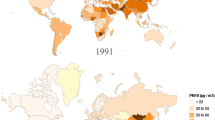Summary
Wind speeds in extra-tropical latitudes are known to be approximately Weibull distributed. Hence a Weibull distribution fitted to all available data is often used to predict extreme winds. The most extreme values then, however, have little influence on the estimated parent Weibull distribution, and the accuracy of the extreme value predictions obtained in this manner may be questioned. In the present paper such a “Weibull method” is compared to a method based on statistical extreme value theory, “the annual maxima method”. The comparison is based on 30 years of 10 minute wind speed averages measured hourly at 12 meteorological stations located at airports in Sweden. Results show that the Weibull method generates incorrect estimates of the tails of the distributions of wind speeds and of the distribution of yearly maximum wind speed, and that serial dependence of individual measurements has to be taken into account. In addition, it is inherent in the Weibull method that it does not provide any confidence bounds for the estimates. The annual maxima method avoids these problems. The measurements were rounded, first to entire knots, and then to m/s. A further, “technical”, result is that if this rounding were disregarded in the estimation procedure, then the computed standard errors of the parameter estimates would be erroneously low. Hence, if rounding is done, it should be taken into account in the estimation procedure. We also believe this to be a clear indication that rounding of the data decreases estimation accuracy.
Similar content being viewed by others
References
Alexandersson H (1979) A statistical analysis of wind, wind profiles and gust ratios at Gränby, Uppsala. Report No 55, Dep. of Meteorology, Univ. of Uppsala
Bergström H (1992) Distribution of extreme wind speed. Wind energy report WE 92:2, Dep. of Meteorology, Univ. of Uppsala
PJ Brockwell RA Davis (1996) Introduction to time series and forecasting Springer New York
S Coles (2001) An introduction to statistical modelling of extreme values Springer New York
K Conradsen LB Nielsen LP Prahm (1984) ArticleTitleReview of Weibull statistics for estimation of Wind speed distributions J Climate Appl Meteor 23 1173–1183 Occurrence Handle10.1175/1520-0450(1984)023<1173:ROWSFE>2.0.CO;2
NJ Cook (1982) ArticleTitleTowards better estimation of extreme winds J Wind Engineering and Industrial Aerodynamics 9 295–323 Occurrence Handle10.1016/0167-6105(82)90021-6
NJ Cook (1985) The Designer’s guide to wind loading of building structures BRE dep. of the environm Garston & Butterworths London
Davenport AG (1967) The dependence of wind loads on meteorological parameters. Proc Int Res Seminar, Wind Effects on Buildings and Structures, Ottawa, Univ. of Toronto Press, 19–82
P Embrechts C Klüppelberg T Mikosch (1997) Modelling extremal events for insurance and finance Springer Berlin
G Kulldorf (1961) Contribution to the theory of estimation from grouped and partially grouped samples Almqvist & Wiksell Stockholm
MR Leadbetter G Lindgren H Rootzén (1983) Extremes and related properties of random sequences and processes Springer New York
Lundtang Petersen E, Troen I, Frandsen S, Hedegaard K (1981) Danish Wind Atlas, a rational method of wind energy siting. Report Riso-R-428, Riso National Laboratories, Denmark
JP Palutikof BB Brabson DH Lister ST Adcock (1999) ArticleTitleA review of methods to calculate extreme wind speeds Meteorol Appl 6 119–132 Occurrence Handle10.1017/S1350482799001103
PF Rasmussen D Rosbjerg (1991) ArticleTitleEvaluation of risk concepts in partial duration series Stochastic Hydrology and Hydraulics 5 IssueID1 1–16 Occurrence Handle10.1007/BF01544174
H Rootzén N Tajvidi (1997) ArticleTitleExtreme value statistics and wind storm losses: a case study Scand Actuarial J 1 70–94
KS Sen JM Singer (1993) Large samples methods in statistics Chapman & Hall New York
Teugels JL (2000) Wind and statistics, a guide to the literature. Report, Dept. of Statistics, Katholike Universiteit Leuven
World Meteorological Organization (1983) Guide to Meteorological Instruments and Methods of Observation, WMO No 8, Geneva
Author information
Authors and Affiliations
Rights and permissions
About this article
Cite this article
Perrin, O., Rootzén, H. & Taesler, R. A discussion of statistical methods used to estimate extreme wind speeds. Theor. Appl. Climatol. 85, 203–215 (2006). https://doi.org/10.1007/s00704-005-0187-3
Received:
Revised:
Accepted:
Published:
Issue Date:
DOI: https://doi.org/10.1007/s00704-005-0187-3




